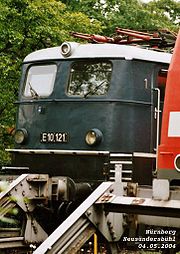
Einheits-Elektrolokomotive
Encyclopedia


Locomotive
A locomotive is a railway vehicle that provides the motive power for a train. The word originates from the Latin loco – "from a place", ablative of locus, "place" + Medieval Latin motivus, "causing motion", and is a shortened form of the term locomotive engine, first used in the early 19th...
) is a German
Germany
Germany , officially the Federal Republic of Germany , is a federal parliamentary republic in Europe. The country consists of 16 states while the capital and largest city is Berlin. Germany covers an area of 357,021 km2 and has a largely temperate seasonal climate...
railroad term for the Class E10
DB Class E 10
The class E 10 is an electric locomotive of the Deutsche Bundesbahn, introduced in 1952. It belongs to the Einheits-Elektrolokomotiven program and was built for express passenger service. In 1968 the series was redesignated as class 110 and class 112...
, Class E40
DB Class E 40
The Baureihe E 40 is a German Standard electric locomotive commissioned by the Deutsche Bundesbahn in 1955, designed for freight trains...
, Class E41
DB Class E 41
The Baureihe E 41 is the first class of German Einheits-Elektrolokomotive commissioned by the Deutsche Bundesbahn in 1956.-Development and first years of service:...
and Class E50 locomotives that were commissioned after World War II
World War II
World War II, or the Second World War , was a global conflict lasting from 1939 to 1945, involving most of the world's nations—including all of the great powers—eventually forming two opposing military alliances: the Allies and the Axis...
by the Deutsche Bundesbahn
Deutsche Bundesbahn
The Deutsche Bundesbahn or DB was formed as the state railway of the newly established Federal Republic of Germany on September 7, 1949 as a successor of the Deutsche Reichsbahn-Gesellschaft '...
of West Germany
West Germany
West Germany is the common English, but not official, name for the Federal Republic of Germany or FRG in the period between its creation in May 1949 to German reunification on 3 October 1990....
. The goal of the Einheits-Elektrolokomotive was to present a common platform on which the engines were based to simplify maintenance and provide interchangeability of parts. This had been done before by the Einheitsdampflokomotive
Einheitsdampflokomotive
The German term Einheitsdampflokomotive, sometimes shortened to Einheitslokomotive or Einheitslok, means standard steam locomotive and refers to the steam engines built in Germany after 1925 under the direction of the Deutsche Reichsbahn-Gesellschaft...
n or 'standard steam locomotive
Steam locomotive
A steam locomotive is a railway locomotive that produces its power through a steam engine. These locomotives are fueled by burning some combustible material, usually coal, wood or oil, to produce steam in a boiler, which drives the steam engine...
s' of the Deutsche Reichsbahn
Deutsche Reichsbahn-Gesellschaft
The Deutsche Reichsbahn – was the name of the German national railway created from the railways of the individual states of the German Empire following the end of World War I....
during the 1920s.
The DB classes greatly exceeded their estimated lifetime of 30 years, many engines of the classes E10 and E40/41 still are in service today, even though they are being actively phased out in favour of newer engines by Deutsche Bahn AG, the successor of the Deutsche Bundesbahn.
For further description of the program see also the article on DB Class E 40
DB Class E 40
The Baureihe E 40 is a German Standard electric locomotive commissioned by the Deutsche Bundesbahn in 1955, designed for freight trains...
.
External links
- There is an English-language discussion forum at Railways of Germany

